Delve into the mind of Athens-based sculptor James Fuller, an artist who embraces an almost scientific approach to his practice. His work predominantly revolves around sculpture, exploring experimental processes in the delicate space between the industrial and the domestic. As the artist describes, he is “turning surfaces inside out,” engaging in a physical dialogue that brings forth pieces suspended between stability and fragility.
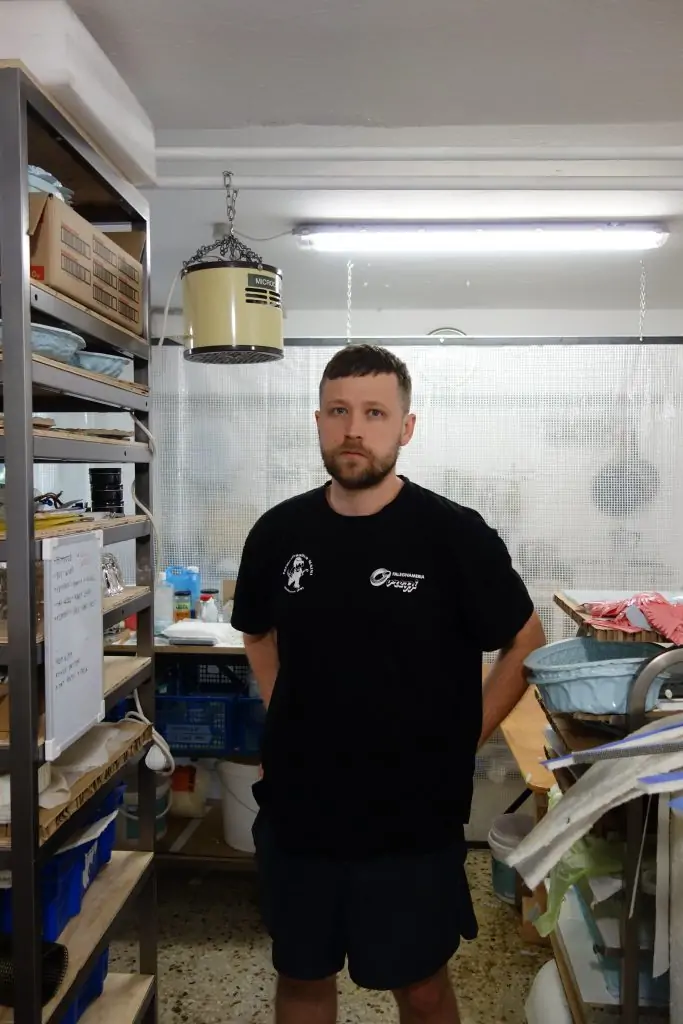
Image courtesy of the artist
Turning surfaces inside and out in quite a physical way to produce works that exist in a sensitive condition between being stable and fragile in the world
James Fuller
Fuller spends meticulous hours executing his extraordinary pas de deux with materials and techniques. His repertoire includes rotational moulding, electroplating, and CNC laser cutting. The resulting sculptures—whether wall-mounted pieces, delicate hollow objects, or avant-garde furniture—are not mere objects but almost living, breathing entities. They embody the delicate balance of their surroundings, inviting viewers to reconsider preconceived notions of form and function, stability and instability.
This meticulous approach is vividly manifested in works like “Slow scroller (the rendering of soft shadows)” (2024), a highly reflective metallic form that captivates with its intricate interplay of shape and texture. Its complex, almost origami-like folds and undulations evoke a sense of movement and stillness, caught in a moment of transformation or unfurling. The reflective quality of the material further emphasises this duality, mirroring its surroundings and becoming part of its environment while standing apart as a distinctly crafted object. This piece contemplates its function, form, stability, and instability.
In Fuller’s current exhibition at South Parade, “The Cart Before the Horse,” he presents a series of sculptures crafted from fragile materials such as copper, beeswax, and textiles. These elements merge to form imaginative interpretations of new patents, blending technology with poetry to provoke thought about our shared consciousness.
Fuller’s work challenges the notion of human exceptionalism and highlights innovation’s slow, sometimes awkward pace. In Fuller’s world, everything seems stable momentarily yet is always susceptible to sudden change or destruction. Through his use of delicate materials and the creation of seemingly ephemeral pieces, Fuller underscores the fleeting nature of ideas and innovation. His work suggests that even the most stable-seeming inventions are subject to rapid transformation or decay.
Fuller’s creative journey is marked by significant achievements, receiving an MA in Sculpture from the Royal College of Art, UK, in 2018 and has exhibited across Europe, winning multiple awards, including Tiffany’s x Outset Award, Kenneth Armitage Sculpture Prize, Stapely Trust Educational Grant, Leathersellers’ Award, and Gilbert Bayes Scholarship. We caught up with the sculptor to learn more about his practice and artistic vision.
Hi James, thank you for speaking with us. Could you introduce yourself to those who might not be familiar with your work?
James Fuller: I’m an artist working out of Athens, Greece, mixed up in producing sculpture that tends to have long choreographies that transfer information between liquid and solid states. Turning surfaces inside and out in quite a physical way to produce works that exist in a sensitive condition between being stable and fragile in the world. Waxes, earth minerals, soap—or metal foils so thin as to be barely there at all in your hand but strong enough to be independent and carry a lot of immaterial weight in their surfaces.
And usually I fight like crazy over long durations to get them to that point, even if they have the potential to melt or wash away, or shift and tarnish afterwards at some point.

Can you share some early moments from your journey into the arts and explain what motivated you to pursue a career in this field?
James Fuller: Damn you’ll embarrass me now, when I started wondering whats going on in the arts, I saw the work of Maurizio Cattelan and Erwin Wurm documented in books. I remember thinking their sense of disruption, or visual disturbance was something I’d never seen. And also, how did they get to that place. That was a severely long time ago. When I started making work, it was collaboratively with two other friends and I value that time a lot even if my work is really different now.
Your practice merges industrial techniques with domestic contexts uniquely. Could you elaborate on the inspirations and themes that guide your work? What philosophical motivations drive you to blend these seemingly disparate realms in your sculptures?
James Fuller: I mean are they disparate? I guess I’d argue they’re indivisible and that’s the point, to collapse that myth that consuming and producing are different matters for different people.
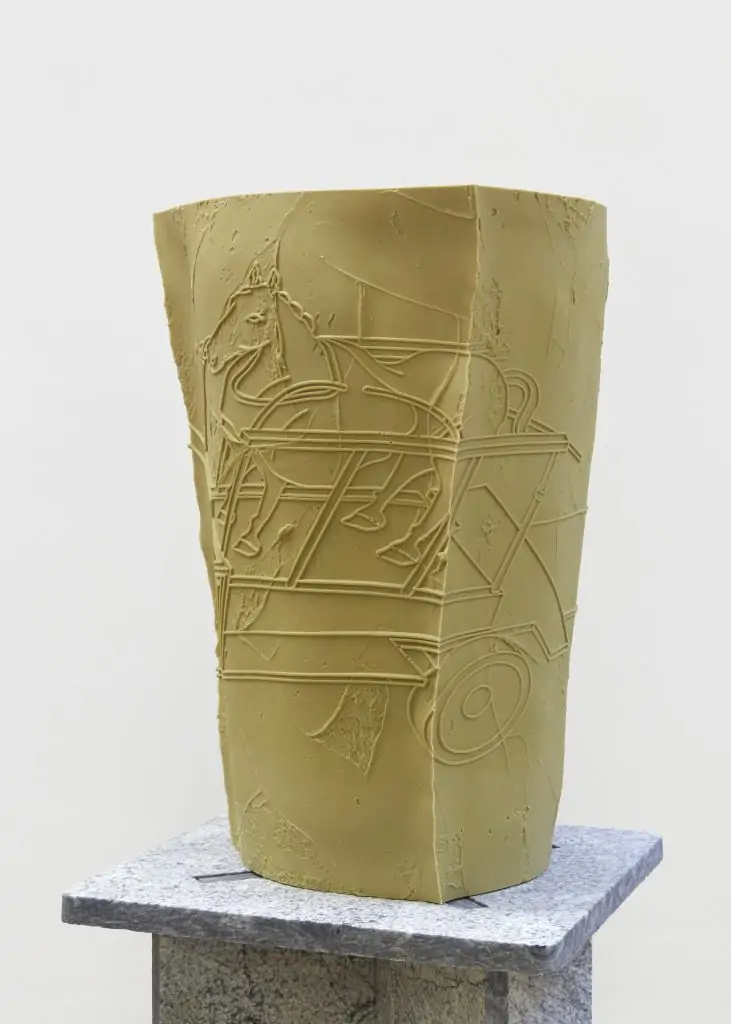
Living and working in Athens, a city with a rich history in sculpture, how has this context influenced your approach to modern sculpture?
James Fuller: It’s a very romantic idea that there is this long continuation through time sculpturally. It’s a city I love to work in because it’s materially and industrially rich now. And local. Emphasis on the local.
There are these ceramic administrative tablets in the archaeological museum, lists of livestock, or other goods. Ceramic inventories—which I love—that became sculpture over time. Maybe they are a relevant connection to the work I make now.
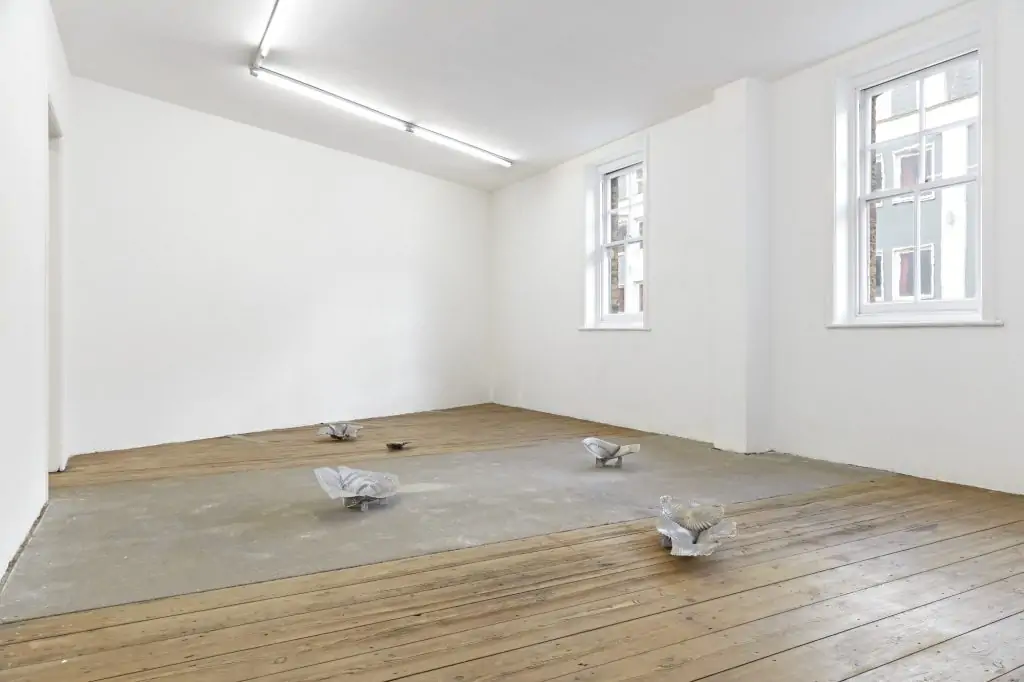
South Parade
Image courtesy of the artist
Having completed an MA in Sculpture at the Royal College of Art, how do you feel your educational experiences have shaped or transformed your approach to sculpture?
James Fuller: To be honest, I don’t attach too much weight to that time. What I know for sure that shaped my work and approach, is all the other years working in and around the arts—with artists, for artists. And in other fields before that. Super warm people with skill and commitment.
As an artist bridging industrial and domestic spheres, could you highlight a piece that exemplifies this balance and its interaction with its environment? Which philosophers or theories have influenced your views on space and form in sculpture?
James Fuller: I recently made a series of machined household soaps (CLEANSING COMPOSITIONS, 2023) that unfold a durational text based work across 52 individual bars of soap. It’s slowly playing out at the gallery through use (South Parade, London). Each soap is wedded to an individual filing with the US patent office, with the language of corporate protectionism seeping into the scented consumer setting and eroding down the drain through the washing of hands. Along with the crisp edges and tooling marks.
Each one starts in such a pristine state they’re almost difficult to hold, but they soon round off into cartoonish volumes, losing information all the time. To be replaced by the next one until the whole work is exhausted.
As for the second part of your question, I’m careful not to attach authors and theorists to my work.
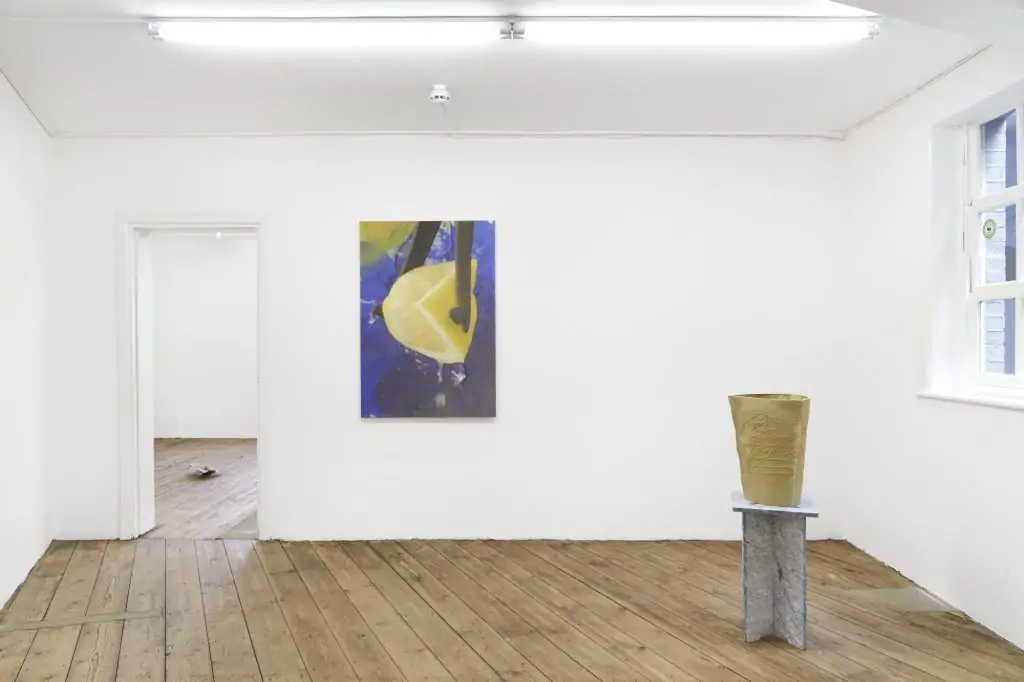
Image courtesy of the artist
You’ve recently opened your second solo exhibition, ‘The Cart Before the Horse,’ at South Parade. Could you tell us more about the essence of this exhibition and what visitors can expect to see?
James Fuller: The hope is for a presentation that feels like it can be read more through fingernails than retinas, even when there’s text physically permeating through the surfaces. And even if the works have quite loaded and serious origins, they open out into compositions that carry sentiments of poetry and irony or humour.
Containing scents and small complexities throughout that will confuse and surprise in equal measure.
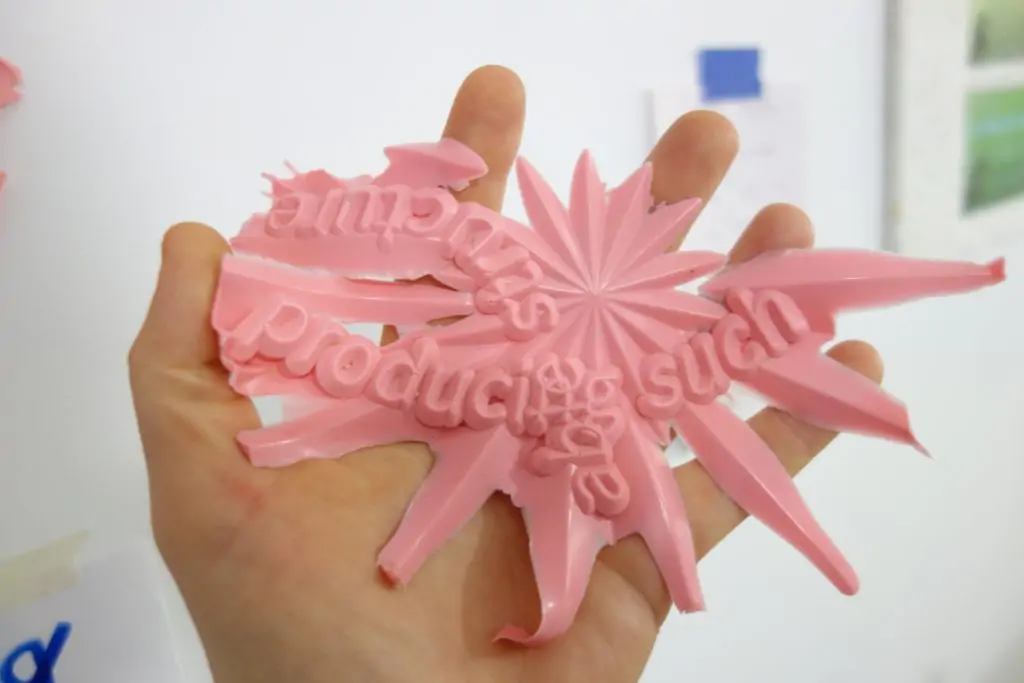
How has your work evolved over time, and are there particular themes or ideas that you find yourself returning to or re-evaluating in your recent projects?
James Fuller: I think a lot about the way works are produced holding a presence in the outcome. That these actions taken to realise something reflect your spirit or politics or concepts and aren’t separate from work you present later. It’s something I’ve been finding ways to negotiate further.
For instance, recognising the importance in my work specifically that there isn’t a kind of wholesome digital trace-like renders or computer generated forms pre-empting physicality. There are lists, and notes, and simple geometries/maps. Instead prioritising a much more haptic process, cutting and stitching the world together by hand. And they only find form, and become anything at all, right in the last moments of that choreography as electrical current or molten wax flows over the surface of the mould .
Intentionally retaining a relationship to technology that is close but often at arms length!
With your integration of high-tech processes in sculpture, what are your thoughts on the role and impact of technology in contemporary art?
James Fuller: I’d say my processes are maybe much more deliberately archaic than it might appear in the finished works.
One of the things in the background of ‘The Cart Before the Horse’, was this kind of fringe American engineer working on AI systems and imagination engines, Stephen Thaler. There’s a lot to be said about him, there’s some great articles you can look up online but fundamentally what I was interested in was how he developed emotive responses between different AI systems using the same kind of powerful peer relationships that affect people. Student/teacher, mother/daughter, boss/employee etc. And then introduced noise, or trauma essentially into this emotive mix to stimulate wilder creative output.
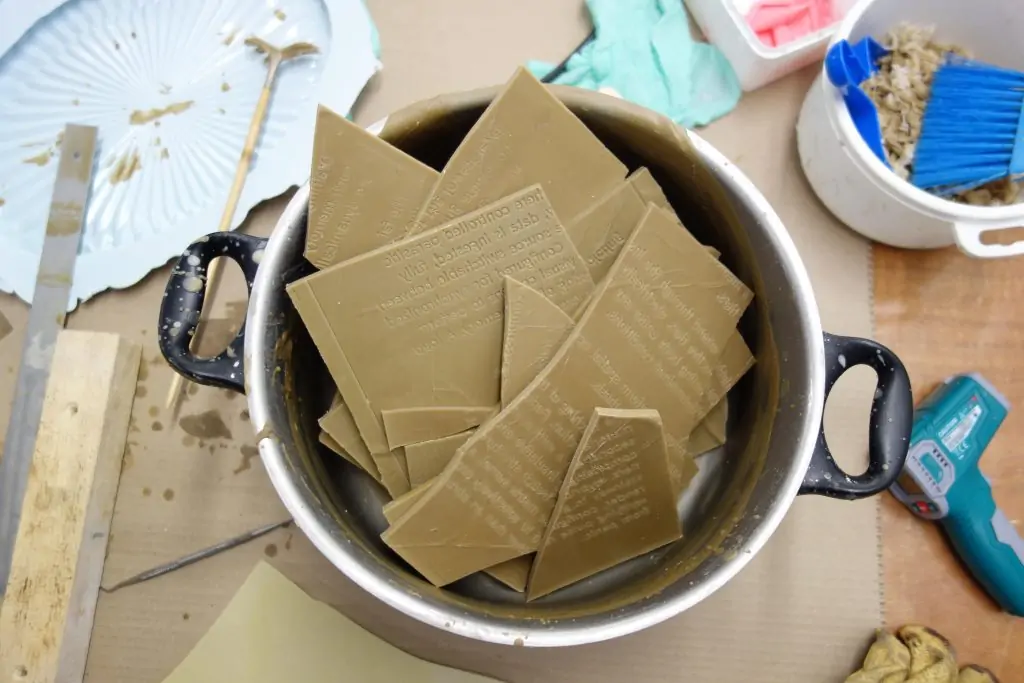
It’s quite well understood how AI can be used to generate output (images, code, diagnosis etc), but I’ve become more focused on the ideas behind generating an AI, or a synthetic imagination, in the first place. Because, at least in his system, its very emotive, very human, very self-reflexive and the lessons can flow in both directions.
I recognised strong parallels in my own generation systems for sculpture and I’ve been embracing them more and more in this show.
If I take a stance on digital and archaic means to produce objects, alternative intelligences, I have to also acknowledge these conversations because they’re interwoven.
Lastly, could you share your philosophy of art? How do you describe and understand the core importance of art in your life and career?
James Fuller: That work isn’t about knowing, or prescribing, or illustrating a position. It’s maybe an admission of the unknown or not needing to know.
I believe people should feel objects and relations that fluctuate between stability and fragility, are intensely worked through yet totally open in another uncontrolled way. Are speculative and delirious but rooted in existing systems of circulation or capital. And constantly in conflict with one another. That’s currency for me but I make them so I can feel them too.
Maybe that’s why sculpture is fundamentally different from other materially rich objects you walk around with in your pocket or live alongside. But it’s a big question you asked!
©2024 James Fuller




